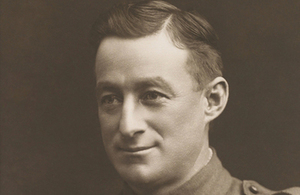WW1 Australian VC recipient Edward John Francis Ryan
The story of Australian First World War Victoria Cross recipient Edward John Francis Ryan.

Edward John Francis Ryan [Credit: Australian War Memorial P01383.013]
66 men from Australia received the Victoria Cross, Britain’s highest award for gallantry, during the First World War. As part of the Centenary Commemorations the people of the United Kingdom marked their gratitude to those courageous men by presenting a bronze memorial plaque to their home country engraved with their names. The plaque is now displayed at the Australian War Memorial. This archive tells their stories.
Name: Edward John Francis Ryan
DOB: 9 February 1890
Place of Birth: Tumut, New South Wales, Australia
Date of Action: 30 September 1918
Place of Action: Near Bellicourt on Hindenburg Line, France
Rank: Private
Regiment: 55th Battalion, Australian Imperial Force
Edward John Francis Ryan, known as John Ryan, was born on 9 February 1890 in New South Wales, Australia. He worked as a labourer until he enlisted in the Australian Imperial Force in December 1915. He joined the 55th Battalion on the Western Front in September 1916.
Private Ryan was awarded the Victoria Cross for most conspicuous bravery and devotion to duty on 30 September 1918, near Bellicourt on the Hindenburg Line in France. His citation explains further:
In the initial assault on the enemy’s position Pte. Ryan went forward with great dash and determination, and was one of the first to reach the enemy trench. His exceptional skill and daring inspired his comrades, and despite heavy fire, the hostile garrison was soon overcome and the trench occupied. The enemy then counter-attacked, and succeeded in establishing a bombing party in the rear of the position. Under fire from front and rear, the position was critical, and necessitated prompt action. Quickly appreciating the situation, he organised and led the men near him with bomb and bayonet against the enemy bombers, finally reaching the position with only three men. By skilful bayonet work his small party succeeded in killing the first three Germans on the enemy flank, then, moving along the embankment, Pte Ryan alone rushed the remainder with bombs. He fell wounded after he had driven back the enemy, who suffered heavily as they retired across “No-Mans Land”. A particularly dangerous situation had been saved by this gallant soldier, whose example of determined bravery and initiative was an inspiration to all.
After the war, Ryan found it difficult to find work. His health deteriorated, and he died of pneumonia in 1941. He was buried with military honours at Springvale Cemetery, Melbourne.